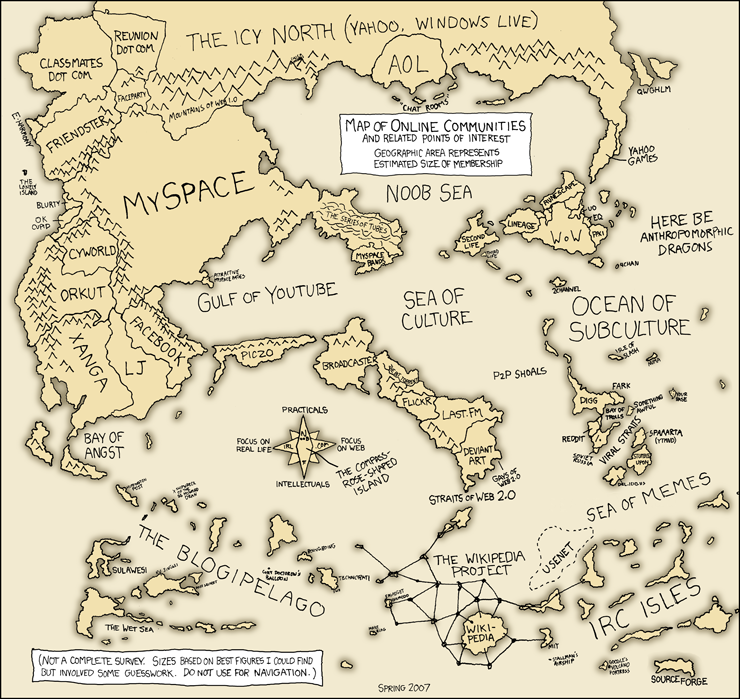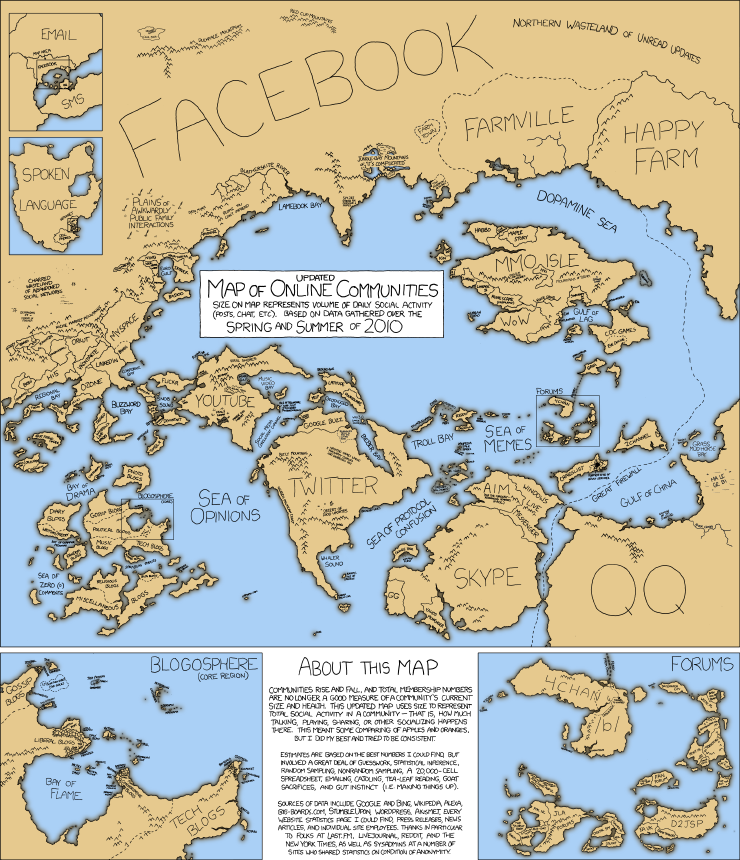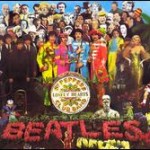Archive for the ‘Online Media’ Category
Ch-Ch-Ch-Changes (continued)
Remember what the social media world looked like three years ago? Probably not because you’re too busy trying to keep up with the new products, devices and services which seem to pop up on your radar screen every day.
XKCD and the marketing firm Flowtown have created “The Map of Online Communities” based on information from sources such as USA Today, Alexa,and Compete which gives some great perspective on how this have changed in the world of social media over the past 36 months.
First, the map of online communities for 2007:

Compare that information with the map for 2010:

Can you find MySpace on the 2010 map? Look southwest of Facebook.
Also, note the growth of Farmville.
How do you think the map will change by 2013?
Thanks to Fred Jacobs of Jacobs Media bring the XKCD/Flowtown maps to my attention.
Words Have Consequences

Saturday’s assassination attempt of Arizona Representative Gabrielle Giffords which claimed six lives has some pointing an accusing finger at radio and cable TV hosts like Rush Limbaugh and Glenn Beck, claiming they had a role in the incident by provoking an unstable person. But INSIDE RADIO reports that the talkers are pushing back, calling it an unfair attack on conservative hosts.



What do you think?
Update: 1/12/11
To alert people to this blog, I posted links on Twitter, Facebook and Linkedin. My experience is that my postings on Twitter never receive responses and are rarely retweeted but I view using it as a connection device to be a learning experience. On both Linkedin and Facebook, I don’t know if people actually link to this site to read the entire blog but they usually post their responses on those sites.
Not surprisingly, the responses tended to fall along party lines. Those folks whose politics tend toward the “progressive/liberal” camp seem to believe that the rhetoric heard on talk radio and cable TV in some way influenced the Tuscon tragedy. Those whose politics are more “conservative” seem to believe that liberals are trying to use the tragedy to impose restrictions on their First Amendment rights of free speech. Unfortunately, South Caroline Representative, James Clyburn (a Democrat) is fanning that particular flame by championing a return of the Fairness Doctrine. I’ve written previously about how anachronistic, outdated and absurd that notion is considering 21st Century communications technology.
In any case, the debate on this topic has certainly been lively. Although I have concerns about what sometimes seems like the irresponsible use of inflammatory rhetoric to manipulate audience reaction and ratings, my sense is that it wasn’t much of a factor in the case of the shootings in Arizona. I was especially impressed with these reactions from columnist David Brooks and The Daily Show’s Jon Stewart:

http://www.nytimes.com/2011/01/11/opinion/11brooks.html?_r=1&ref=davidbrooks
href=’http://www.thedailyshow.com’>The Daily Show With Jon Stewart
| Daily Show Full Episodes | Political Humor & Satire Blog</a> | The Daily Show on Facebook |
Polls show that 60% of Americans don’t believe that political rhetoric caused Jared Loughner’s assassination attempt on Rep. Giffords. Nevertheless, it seems to me that those who dismiss the impact of inflammatory rhetoric are making a mistake. Research shows that humans, even those of us who relieve that we are reasonable and rational, react emotionally and then rationalize to reinforce their beliefs.
In times of economic instability like we’ve been experiencing for the past decade in the United States, fear, insecurity and distrust become more prevalent as what Seth Godin likes to call our lizard brain takes control. Couple with that the ability that we have with the internet, various cable TV and social media to filter the information we receive. Now, we can choose to avoid all that inconvenient information which doesn’t reinforce our beliefs.
I can recall watching coverage of the 2008 Presidential campaign when a woman in John McCain’s audience started ranting about how Obama was evil and wanted to destroy America. The woman looked like an average grandmother but she was regurgitating this rhetoric and McCain looked stunned and embarrassed. He felt it necessary to reassure her that Barack Obama was a good person and an honorable man, not something that this woman or his supporters wanted to hear.
Another woman waiting in line to enter a McCain/Palin rally told an interviewer that Obama was a socialist who wanted to destroy the country and that he wasn’t an American citizen. She was very matter-of-fact as if these were proven facts rather than unsubstantiated rumors spread through the internet.

Albany Times Union editor, Rex Smith makes some cogent observations in this recent editorial:
http://www.timesunion.com/opinion/article/Words-the-first-step-to-civility-959442.php
Those of us who’ve worked professionally in media know how easy it is to manipulate an audience. It can be a source of childish delight to watch your audience jump through hoops at your whim but it’s also important to take responsibility for your actions and for the results of those actions whether or not they are intended.
Words have consequences.
2011 Web Threat Predictions
If you use a smartphone and especially if you’re an iPhone, iPad or Mac user, pay attention. I know, the folks at The Apple Store told you that you really don’t need anti-virus protection because Apple products are virus-proof. But that could soon change. Like squirrels trying to access the food in your bird feeder, hackers are apparently obsessed with cracking the Apple codes.

PC Magazine reports:
McAfee on Tuesday (12/28/10) released its list of threat predictions for 2011 and it highlighted things like URL shorteners, location-based services, Apple products, and Internet TV. McAfee on Tuesday released its list of threat predictions for 2011 and it highlighted things like URL shorteners, location-based services, Apple products, and Internet TV.
What else made McAfee’s threat list?
• Hacktivism: McAfee predicted a rise in the number of politically motivated cyber attacks. “More groups will repeat the WikiLeaks example,” McAfee said, though strategy will become more sophisticated and leverage social networks.
• Friendly Fire: McAfee predicted a rise in the use of malicious content disguised as e-mail from sources you know. “Signed” malware that imitates legitimate files will become more prevalent, and “friendly fire,” in which threats appear to come from your friends but in fact are viruses such as Koobface or VBMania, will continue to grow as an attack of choice by cybercriminals, McAfee said. This could go hand-in-hand with social network attacks, which could eventually overtake e-mail attacks.
• Botnets: McAfee Labs predicts that the recent merger of Zeus with SpyEye will produce more sophisticated bots due to improvements in bypassing security mechanisms and law enforcement monitoring. Additionally, McAfee Labs expects to see a significant botnet activity in the adoption of data-gathering and data-removal functionality, rather than the common use of sending spam.
You can read the entire PC Magazine article here:
http://www.pcmag.com/article2/0,2817,2374784,00.asp
The Contract And The Covenant
At a recent Catholic wedding I attended, the priest spoke to the bride and groom about the difference between a contract and a covenant. He talked about how the union they were undertaking was not a contractual arrangement like a business deal but a sacred promise to each other and, by extension, to God.
This was the first time I can recall hearing this issue addressed during a wedding ceremony. It seemed apt and it got me thinking.


My generation, the Baby Boomers, grew up in the aftermath of World War II. It was the age of nuclear proliferation, a time of major scientific discoveries which helped provide answers to many of our questions about the universe and which (like the birth control pill) provided us with more control over our destinies. We witnessed the coming of age of the feminist movement and experienced the “Summer of Love” along with the era of disillusion and anti-heroism following the Vietnam War which led to the Gordon Gecko “Greed Is Good” 80s.
We went from a generation of idealists to a generation of cynics to a generation of pragmatists. No wonder we started thinking of marriage more like a business agreement and a matter of mutual convenience. Of course, the inevitable result was the burgeoning divorce rate among Boomers which must have created psychological concerns about commitments for our children.
When Googled the question “What is the difference between a contract and a covenant?”, one of the results was this: “The difference is in the attitude of contract versus the attitude of covenant. In contract both parties are hoping to limit liability or maximize profit or otherwise make things better for the self. The contract is then a way of ensuring that things go just as planned and, if necessary, to force the other party to promised action….A covenant relationship is one in which certain terms are set, yes, but the parties make the cause of the other their own cause. In other words, when I make a covenant, the goals and desires of the person with whom I am covenanting become my own.” Sounds about right.
So, have the children of Baby Boomers learned a valuable lesson about marriage and long-term relationships from our mistakes? Or is this just wishful thinking?
Your thoughts?
Another Customer Service Horror Story
 Just prior to the Thanksgiving holiday, my brother’s Hotmail account started sending out one of those “I’m stranded in Spain, my wallet’s been stolen and I need you to send me $$$ so I can get home”– email scams to contacts in his address book. I learned about it from friends who contacted me to ask if my brother was aware that his email had been hacked. Oddly, I never received the email directly from him because, as we learned later, somehow my address had been deleted from his contact list.
Just prior to the Thanksgiving holiday, my brother’s Hotmail account started sending out one of those “I’m stranded in Spain, my wallet’s been stolen and I need you to send me $$$ so I can get home”– email scams to contacts in his address book. I learned about it from friends who contacted me to ask if my brother was aware that his email had been hacked. Oddly, I never received the email directly from him because, as we learned later, somehow my address had been deleted from his contact list.

The situation became more complicated because we were both visiting my mother in New England and her home is equipped with only dial-up internet service and also because my brother, who also only has dial-up service at his home, had signed up for his Hotmail account on a computer at his local library several years ago.
Consequently, when my brother attempted to change his Hotmail password, the system didn’t recognize my mother’s computer and asked my brother for the answer to his secret question. However, the automated Hotmail system didn’t remind him about what the question was and it had been so many years since he’d joined Hotmail that he didn’t recall the question. So, throughout the day on Thanksgiving and continuing through Sunday night, he kept trying to contact Hotmail customer service but the automated system kept giving him the runaround and bouncing him back to his original screens.

When I returned home, I Googled Microsoft customer service and found an 866 number. However, when I called that number there was no option to connect with a Hotmail CSR nor one to connect with a live body. Considering all the criticism that Microsoft has been getting in the techie world during the past several years, I was amazed as well as frustrated.
Fortunately, when my brother returned home on Monday night, he received an email from Hotmail which helped him to change his password. As far as we’re aware, no harm was done however we still find it astonishing that it was such as hassle and took five days to rectify a pretty simple problem. Given 21st century CSR technology, we would have been happy to talk with a live body in the Philippines or Mumbai rather than to just go round and round with an automated customer response system.
What’s your customer service horror story?

Buzz4Boomers
During 2010, the oldest Baby Boomers turned 64 and, no doubt, wistfully hum the Paul McCartney tune while the youngest boomer will celebrate their 46th birthday. It’s got to be pretty discouraging to those younger boomers that HR departments now consider anyone older than 40 to be over the hill.

The original name for this blog was Buzz4Boomers and its intent was to provide information was to serve a translator of information about new technologies and social media for those Baby Boomers who tend to be intimidated by change. One thing I know about myself is that I am not an early adopter. But I am fascinated by new discovery and tend to be optimistic about the future. So, I frequently find that I fall halfway between those folks who are always using the hottest new technology or social media tools and those who are at the other end of the bell curve.
My challenge is that I tend to be a dilettante with a range of interests that’s a mile wide and a base of knowledge that’s an inch deep. So a review of my blogs over the past couple of years shows diverse topics such as the story of my customer experience using social media in negotiating with a large chain store, rants about musicFirst and the Performance Rights Act, and stories about augmented reality.

When I evaluated my professional broadcasting career after I left the industry in 2007, I realized that what I really enjoyed most about my job as a program director and on-air personality was helping people find ways to cope with the challenges in their lives. That could happen when I was able to provide important health or consumer protection information during a public affairs show or by simply playing a song that provided a listener with a brief distraction, sense of joy or peace of mind.

My ultimate goal for this blog is to make you aware of ideas/ events/ discoveries that are impacting our world and that a reader might not have encountered in hopes that it will provide some assistance in coping with change.
Epidemics & Social Networks
The social networks that Nicholas Christakis discusses in his TED presentation this past summer aren’t the high-tech internet-driven social media which that term now tends to infer but actual interactions between live human beings.
What can we learn from these insights?
Thanks to Daniel Anstandig at McVay Media for making me aware of Nicholas Christakis’ TED talk.
Augmented Reality Goes Mainstream
This week was our wedding anniversary so I was in our local Saratoga Springs, NY Hallmark store looking for a card for my wife. While I was perusing their selection, I noticed a video display and was amazed to discover that Hallmark is embracing Augmented Reality.
Here’s a video posting from MommyReporter:
I first discovered AR last summer around this time and have been fascinated by its potential. Most people are still unaware of Augmented Reality but now that a mass appeal company like Hallmark is employing this technology, I expect to see a lot more market penetration for AR during the next 12 months.
Here’s a link for the Hallmark website:
Your thoughts?
Shopping In 3D
Earlier this year, I showed you how augmented reality can be used as part of the clothes shopping experience. Now, YOUReality and metalio have created an Online Retail Visualization 3D tool to help you see how furniture, appliances, electronics or other accessories might look in your current living space.
And for your iPhone:
How soon do you think it will be before you start taking this type of technology for granted?

